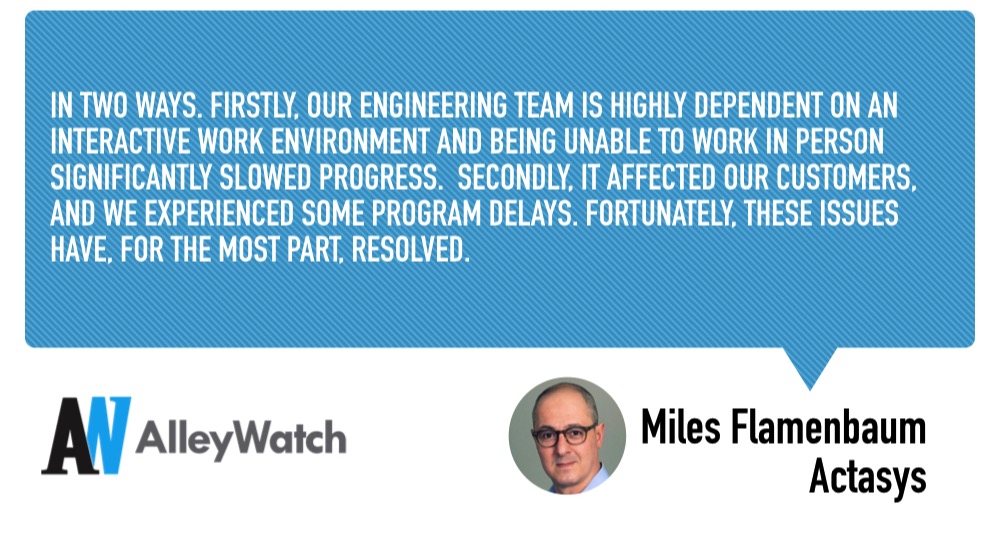There are approximately 22 billion sensors used in the automotive industry per year according to a 2017 study and the average automobile has at least 60 individual sensors. The push towards autonomous vehicles will only increase the number of sensors used exponentially. Actasys has built a critical sensor-cleaning technology for vehicles and smart mobility systems ensuring that these sensors can be operated continuously safely. ActaJet™ is an electronically controlled array of actuator cartridges that generates strong jets of air without the need for mechanical pumps or compressors. The company is partnered with automotive companies like Volvo and the technology is also being deployed in other use-cases such as robots, camera systems, traffic monitors, and more.
AlleyWatch caught up with CEO Miles Flamenbaum to learn more about the core technology, its practical uses, and the company’s recent funding round.
Who were your investors and how much did you raise?
$5M in Seed funding from Volvo Cars Tech Fund and NextGear Ventures.
Tell us about the product or service that Actasys offers.
Actasys is commercializing ActaJet™, an electronically controlled array of actuator cartridges that generate strong jets of air, locally, without the use of a mechanical pump or compressor. The lead application for ActaJet is the cleaning of optical sensors on vehicles and smart cities camera systems.
 What inspired the start of Actasys?
What inspired the start of Actasys?
Actasys has a deep background in aerodynamics and the principles of active flow control. Our technology is based on the concept of synthetic jet actuators that come out of those fields of study. We recognized that the cleaning and clearing of sensors, particularly on moving vehicles, is fundamentally an aerodynamic problem and focused our efforts on developing the solution.
How is Actasys different?
We generate a jet of air without the need for mechanical solutions that require pumps, compressors, valves, and nozzles. This makes our approach much simpler to apply and integrate. Further, as we control the system electronically, it can be adaptive and interactive.
What’s your business model?
We work with automotive and camera system OEM’s and Tier-1’s to design, develop, and integrate our solution into their products. For low volume applications, we can assemble the system and for high volume applications, we are establishing manufacturing partnerships. We then enable our customers and suppliers to produce the system under license.
How has COVID-19 impacted your business?
In two ways. Firstly, our engineering team is highly dependent on an interactive work environment and being unable to work in person significantly slowed progress. Secondly, it affected our customers, and we experienced some program delays. Fortunately, these issues have, for the most part, resolved.
What was the funding process like?
As it was our first venture funding for a developing industry sector and new technology, it was painstaking but enlightening.
What are the biggest challenges that you faced while raising capital?
Given the size of our team, the biggest challenge was to maintain progress with product and customer development while devoting significant time to fundraising.
You are seconds away from signing up for the hottest list in New York Tech!
Join the millions and keep up with the stories shaping entrepreneurship. Sign up today
What factors about your business led your investors to write the check?
The investors recognized the developing industry need for sensor cleaning, the complexities that existing approaches are burdened with, and how our approach had unique and defensible competitive advantages.
The investors recognized the developing industry need for sensor cleaning, the complexities that existing approaches are burdened with, and how our approach had unique and defensible competitive advantages.
What are the milestones you plan to achieve in the next six months?
We will be advancing our first product to application readiness and have several commercial milestones regarding advanced customer relationships that will be achieved during that time.
What advice can you offer companies in New York that do not have a fresh injection of capital in the bank?
Each company, technology, sector, etc. is so different, it’s hard for me to think of general advice other than mind cash flow and focus on your go-to-market.
Where do you see the company going now over the near term?
We are entering into a growth phase where we have significantly increasing demand for our products. This requires growing both our product and business development capabilities to capitalize on the demand.
What’s your favorite outdoor dining restaurant in NYC?
Cornelia Street Café, while I moved to the ‘burbs several years ago, my wife and I used to live in the West Village and that was our place to meet after work almost every Friday.





